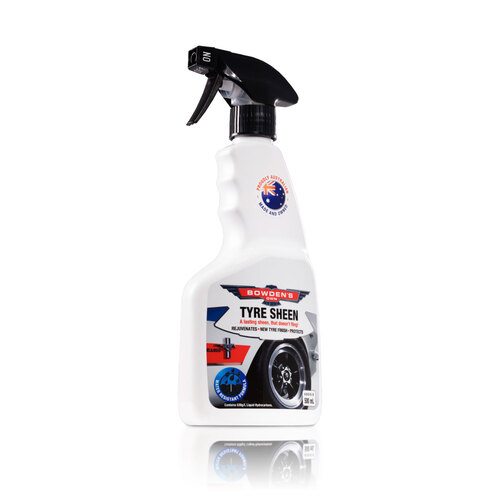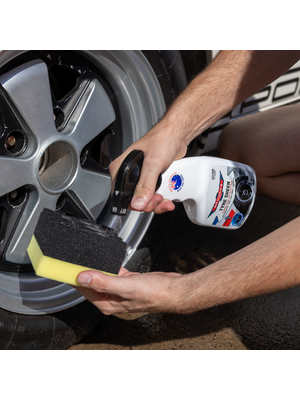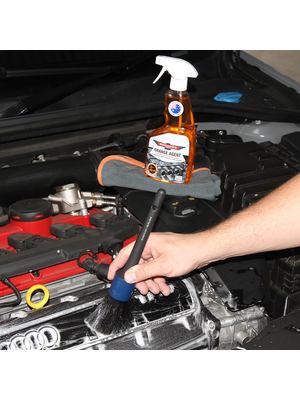Easy cleaning of heavy brake dusted wheels
The beginning
It was in 2002 when we began looking into making a wheel cleaner. We already had a set of alloy wheels with the finish badly damaged thanks to a big names' supposedly safe “all wheels” cleaner, which was obviously not safe for ours. Not wanting to have this ever happen to anyone else, the chemists were given the task to make a safe one for us. A lot of different formulas were put forward, but we found holes in all of them. We needed something pH balanced, i.e. non acidic or alkaline, biodegradable and be safe for ALL wheels. It also had to cut the time down in cleaning the round friends on our cars.
We were recommended a new type of wheel cleaner made by a large German company, which worked surprisingly well, but the toxic smell had us gagging! Finding out what the ingredients were I was very happy not to be inhaling it anymore, as a great carcinogen was being used in its formula. But cancer catching ingredients aside, it worked quite well and had a funky colour change reaction on the wheel, so we began to look a bit closer.
Young Casey who works for us mentioned that it smelt a lot like a hair treatment they sometimes use in hairdressers. She also mentioned how good this hair care product was for cleaning metal in the salon. From that we were able to isolate the active ingredients and began trying to work out how they could be made into a real car care product. So starting from scratch our journey to make this specialist wheel cleaning formula began!
Our latest update coming in July of 2018 is now the 6th update since we began formulating the product 7 years ago. We've affectionately named it the "Ballistic" version (designated on the back of the bottle with a (B)). Through the help of our chemists and real world feedback from ourselves and some keen professional detailers, we have now built a totally unique product from 14 quality ingredients, all custom blended in our Queensland factory to be of a world class quality.
In short, here are the new, bigger changes:
• No longer smells like arse
• More effective on brake dust
• Deeper cleaning of grime
• Longer working time
• Slower drying and more hydrophilic
• Easier on porous or unsealed finishes
What is it?
Wheely Clean is a revolutionary type of cleaner that utilises a chemical reaction with metal oxide/brake dust that changes its state to a water-soluble complex, for easy removal with a pressure washer or hose. It will do about 90% of the cleaning job for you on really dusty wheels and close to 95% or more if used weekly on a daily driver. With its strong emphasis on grime cleaning, the active degreasing ingredients do a great job at removing built up road grime you can expect on any wheels. It's pH neutral and contains no acid or alkaline ingredients, so it's safe for all wheels including painted, alloy, anodised, chromed, clear coated, powder coated, aluminium, stainless, billet, ceramic coated - the list goes on!!

No Longer smells like arse
First and most noticeable change is the smell. Wheely Clean has become quite infamous for its nose singeing smell that for lack of better words, smelt like arse (although I am no expert on this). For years the smell alone has been able to completely polarise people who have used it; some hate it, some like it, and most simply tolerate it as the product cleaned brake dust caked wheels so damn well.
The ingredients used to make the purple chemical reaction with ferrous iron/brake dust have been around since the late 1920’s where it was used as a chemistry test for iron. Versions of it are now used by many car care companies for wheel cleaning and iron decontamination from paint. It’s a complex and time-consuming job to stabilise all the ingredients into a final pH neutral formula we require, and it was part of this balancing process as to why the previous formulas smelt so damn bad. But, we have a new way to do this with pharmaceutical grade, low odour ingredients that are very new to the market. We are the only company using these new ingredients in Australia and consequently they are a bit more expensive, but as our focus is always on the final product quality, we think the slight rise in the product price is well worth it.
The chemists have done an outstanding job at removing the stench - mind you it still doesn’t smell of roses - but it’s night and day compared to the older formulas we had. A big thing to note, is DO NOT smell this by unscrewing the trigger to get a whiff direct from the bottle, as all you get is the head of its fumes and it’s not at all indicative to how it should smell. If you need to know what it smells like, the only real test it is by spraying it, so you smell the actual liquid product all mixed together correctly. Maybe best if you don’t do this inside your local Auto store though…
Better on brake dust
The ingredients that create the iron reaction are an important part of this formula and the more brake dust you have, the more dramatic the colour change will be. Our extensive testing of multiple formulas we created and other highly regarded products already on the market, showed some interesting things when it comes to the colour change and brake dust removal. Many that had an extreme colour change, did not really clean dirty wheels that well. Learning from this, we have made this version so it has the colour change effect people like to see if you have bad brake dust issues, but if you don't have bad brake dust, you will still get a reaction and be happy that we have put a stronger emphasis on the next item below.

Deeper grime cleaning
From feedback and our own personal experience, the grime aspect was a huge priority and is the most important difference between a true wheel cleaner and an iron decontamination product. As wheels cop a huge amount of oil, grease and all other matter of road grime, we focused on a better grouping of multiple surfactants and degreasing agents to target this. I would now say this new Wheely Clean is almost twice as good on grime as the previous versions and our tests confirmed this when used against many other highly regarded “not off the shelf” wheel or iron decontamination products as well.
Slower drying, longer work time and hydrophilic
The previous formula could dry too fast for some and if you were unfortunate to have the experience of not using it the way we say and it dried, you would be hand polishing away the white residue. So we have slowed down the drying and iron reaction time, so people can be more relaxed when using it and not be running around like a mad chook if they are doing multiple wheels at one time. We also made it more hydrophilic (the product hangs together and doesn't separate), with the same viscosity the older formula had, so it still hangs onto the side of the wheel, but will spread more evenly for an effective clean.
Easier on porous or unsealed finishes
This was another item we targeted, as not all finishes on wheels or brake calipers are the same. Never an issue for anyone with good quality sealed or painted surfaces, but we have seen badly finished or unsealed finishes get a white residue if Wheely Clean was applied to a warm area or left for far too long or dried. These surfaces get this way as wheels and calipers go through many thousands of dramatic, long heat cycles, compounded when they are cleaned with harsh acid or stronger alkaline wheel cleaning formulas that all work to compromise the surface finish and create issues. We did a lot of real world testing on LOTS of cars, including a few HSV’s over the last 6 to 8 months, locally and at our many public demo nights as well. We are confident that this new formula has now addressed these issues. As always, follow the product directions and test it first if you have any concerns. The one thing we could not help was on the rare unsealed zinc callipers that have some iron content, it can make them darker as the formula reacts with the iron, so again be smart and check before use with a quick test in an inconspicuous area first.
Can it stain my driveway?
As Wheely Clean is water soluble, it washes away with water, so make sure you rinse the area well around your wheels when done. Most surfaces have no issues, but we have seen some slight marks on old, unsealed concrete if not washed away and left to dry, but they can be easily scrubbed off. If you have any concerns you can always wet the area around the wheels before use.
Interestingly, you will notice the colour reaction also happening on the ground after rinsing the area down the first time. This is because the brake dust is washed off the wheel and the chemical reaction continues after getting cleaned off the wheel. So, don't be scared to give a second rinse to the wheel area 5 minutes later, or wash the car straight after cleaning the wheels (which is what we do).

How to use
It’s pretty simple to use, but there are a couple of simple tips to remember. Firstly, don’t let it dry; if you do, it means you will have to go and give the wheels another wipe, meaning more work! Use it in the shade and ensure the wheels and brake callipers are cool to touch. Like any type of wheel cleaner out there, with some brake rotors, zinc plating can be affected near the hat, but it’s a simple fix to just have this area sprayed and sealed in a heat-coated paint. In nearly all cases it will not bother most people, as the wheel usually hides this area of the rotor.

Step 1
Easy application
Shake the bottle really well, then spray onto a dry wheel in a sweeping motion. Do one wheel at a time, making sure to get good coverage. If the product does not get on all the brake dust and grime in the wheel, it cannot clean it off. This is why we like to suggest using a wheel brush like our Little Chubby brush. It has a 'unique' smell - that's normal. If you're the rare one who is a bit sensitive to it, we would suggest wearing a mask.
Leave it on the wheel for about 30 seconds to 1 minute, until you start to see the liquid turn purple.

Step 2
Brushes for dirtier wheels
A wheel brush is good to spread the product around on dirty wheels, especially when cleaning off heavy brake dust or grime. We recommend and use our Little Chubby brush and the Wheel Woolies for this job. The Wheel Woolies are great for getting into the wheel barrels and behind the spokes, and the Little Chubby is excellent for cleaning the wheel faces with its long and soft tipped bristles.
Using these brushes with a lubricating mix of one of our washes in our Wheels bucket, in conjunction with the Wheely Clean, will give an excellent and thorough clean for your wheels.
We don't sell the Wheel Woolies through our retail networks yet, but we do sell the Little Chubby brush and the bigger Big Black One brush for wheel arches and similar, through our supporting retailers.

Step 3
Watch the colour change
You will see a change of the product from clear to a purple, dark red, even black colour (if there is really heavy brake dust or grime). This colour change is the unique and safe chemical reaction breaking down the brake dusts' iron particles into a water soluble complex on the wheel.

Zombie wheels...
Close up of the chemical reaction at work. You can see why we almost gave this product the name zombie wheels!
It's important to point out is that it's safe on the wheels' surface and this chemical reaction is doing most of the hard cleaning work for you.

Any questions?
You can get this epic wheel cleaner at all of our great retailers nationwide. Find your closest store in the link at the bottom of this article.
If you have any questions or feedback about this article please contact us by email - info@bowdensown.com.au or call our office on 1800 351 308.
Love your car,
Dan Bowden

Finish it right
To finish it off right, get some of our Tyre Sheen. It leaves the perfect finish on the tyre, not too shiny, but not dull as you can see in the final shot here. This does not fling off onto your car, will not wash off in water and it smells like jam doughnuts!
Apply with one of our All Sorts applicators, for the perfect finish. The best tyre shine product we can make and loved by so many of our great fanatical car care fans.

Paint decontamination?
Some of the professional detailers might see this product as an ideal decontamination tool for cleaning embedded iron in your cars' paint. It does work for this, however we don’t suggest using it for this job as it contains degreasers for wheel cleaning, that are not needed for iron decontamination on paint. Instead, use our dedicated decontantamination product .
Biodegradable? Unique fragrance...
Yes, Wheely Clean is a biodegradable product.
This product does have a unique fragrence. Our chemists worked extremely hard to get this products' smell to where it is today. Compared to other iron reactive wheel cleaners on the market, Wheely Clean is much less offensive, while still being extremely effective.

Step 4
Hose it off
After leaving the Wheely Clean for around 1 minute until the purple reaction has hit its peak (its peak is right before it starts to turn yellow), thoroughly hose it off with a strong stream of water. We recommend using a good pressure washer for a perfectly clean wheel! It all washes straight off with water, no dangerous residue, very quick and easy.
Wipe dry with a clean cloth, or as we suggest, take it for a drive around the block which also cleans the residue off the brake rotors. For extra protection on your wheels, apply Fully Slick or Wet Dreams - this will help repel some brake dust and make the wheels easier to clean next time.

Exposed nuts
Wheel nuts that is. Like on a lot of our older race cars like the Ford GTHO's. We spray the steel wheel nuts with an anti-rust agent like a lanoline spray and wipe the area down so you dont get oxidisation on any exposed steel.
If the nuts are rusted you will see the formula remove the rust. Just be sure to spray them with lanoline spray afterwards.

Brake rotor faces
On the bare steel face of the brake rotors you will sometimes see some light oxidisation residue form after washing. Our suggestion is to take the car for a drive and the first time you hit the brakes, it will all be cleaned off.
Ceramic brakes
If you have the uber expensive ceramic pads fitted, you will not see the purple chemical reaction as there is no iron in the pads, but you will notice it still works great as a cleaner. Perfectly safe and recommended to use for these types of brake pads.
Wheely Clean and other iron reactive wheel cleaners are not suitable for carbon ceramic brake rotors.
Safe on plastic dipped, ceramic coated wheels and more
Yes, it's safe on plastics. Things like wheel nut covers, wheel centre caps, mud flaps, inner body covers etc, even protective films like spray on plastic dipped wheels and vinyl wraps. Being pH neutral, it's also safe for regular use on ceramic coated wheels.
Tar remover?
Wheely Clean will not remove tar from your wheels. For this, we strongly suggest our great Ta Ta Tar cleaner, nothing works better than that!
Looking Green?
It can turn some lead wheel weights green. If it concerns you, don’t worry, as you can easily bring back the original grey finish with a gentle scrub with a brush or cloth and one of our car washes, or our Orange Agent cleaner.
More tips and notes:
Effectiveness
We say that the Wheely Clean, when used without agitation or a wheel brush, will clean about 90% of the grime away on dirty wheels when used with a pressure washer. Now this is with road grime, which usually comes if you have driven in rain and the like. Also, the first time you clean a really dirty wheel (especially inners) it could be a lot less, so you will need to use some agitation or wheel brushes to help the Wheely Clean out. After this initial clean, if it's just brake dust, it will clean closer to 95% of it off when used with a good pressure washer. We strongly recommend that you continually clean your wheels on a regular (weekly) basis to keep it working this way.
For a 100% clean, use a good, soft bristle wheel brush (like our Little Chubby or the Wheel Woolies), especially for the heavier built up areas like the inner wheel barrel. It only takes an extra minute to do and is worth the minimal effort used.
All done
Now that's a rim-markably, mag-nificent, Wheely Clean rim. ;)

Products Used
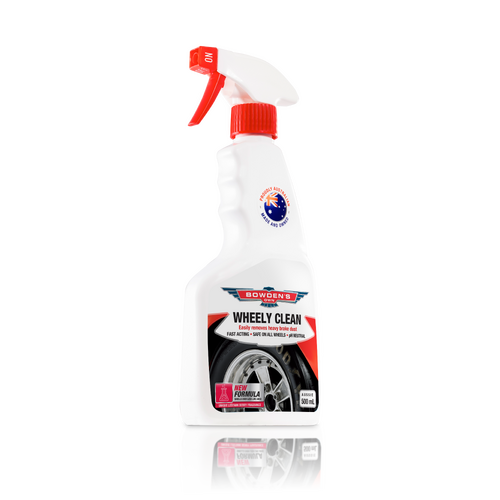
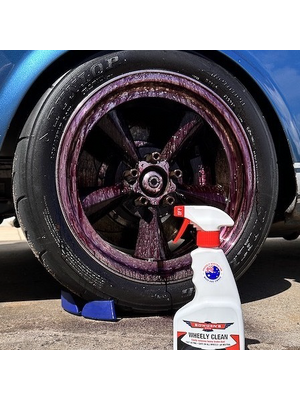
Wheely Clean
Our latest version of Wheely Clean that works better, goes further and no longer stinks!
$28.99


Dirty Deeds
A very useful 2 cloth pack, created for all the dirtier jobs around your car and bike.
$27.99

